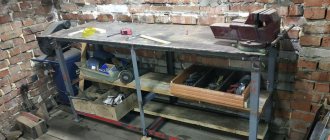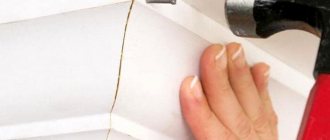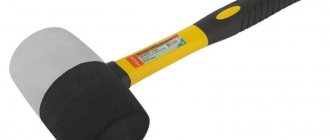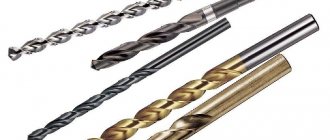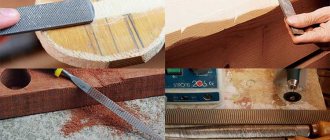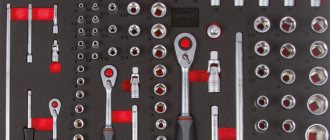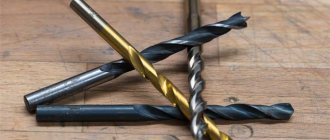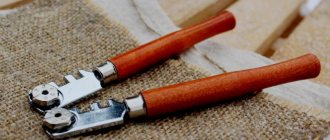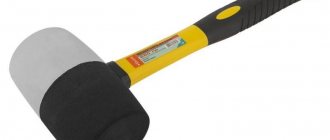Types of squares
The large number of areas that use this tool has led to the emergence of a wide variety of models. They all differ in functionality and purpose.
Among the most popular are the angles:
- Drawing purpose. The simplest and most common type, which is made in the shape of triangles with angles of thirty, forty-five, sixty and ninety degrees. They are also marked with measuring lines, which allows you to measure small straight lines. Traditionally, such devices are used in schools for geometry or drawing subjects, since they can easily be used to construct straight or oblique lines.
- Verification type. It is used for checking perpendicularities and is popular among engineers. With the help of such a tool, precise structures are checked, the assembly of which requires increased attention. The appearance of the verification models consists of two rulers, which are connected at angles of ninety degrees. These squares are very versatile, so there are no restrictions on areas of use.
- Joiner's model. They are in great demand in furniture production, as they measure right angles very accurately. Often, carpenters use ordinary, marking types and Svenson squares. The designs of such devices are much more complex than conventional ones and contain not only a triangle, but also protractors, marking thicknessers and rulers. It is important to understand that such models are not entirely suitable for domestic purposes, because only a specialist can understand them and use them correctly.
- Construction variety. It is worth noting that builders use a wide variety of models of such devices. Here it becomes necessary to measure tile corners, mark drywall and wooden boards. Only squares for masons have exceptional differences. They are very bulky and therefore not in demand in other professions.
Description
There are several types of squares depending on the application:
- UP - flat angles. Squares with metal flat plates differ in width and thickness. Used for all types of construction. A mechanic, carpenter, milling machine operator, or turner cannot do without such a tool.
- УШ - the corner has a wide base. One side consists of a T-shaped profile, the other is flat, they are connected to each other at a right angle.
- ULP - pattern testing squares. They are used for precise measurement of finished products, parts, and structures. Accurate measurement in ultrasonic testing
Wooden and plastic are suitable only for carpentry work.
New angles on the market
Modern conditions of work require the development and production of some special angles.
The following instruments are called improved and modified:
- With liquids for measuring levels. It is very suitable for builders, because it provides the opportunity to measure the level and immediately apply the appropriate markings.
- With malka device. A design tool that is capable of measuring angles and putting them in the same position on diagrams or drawings.
- With magnets. Welding jobs often require certain elements to be fixed, and special magnetic clamps have been manufactured to maintain certain angles.
In general, you have a huge selection of models from conventional to more accurate and modern ones, with advanced functionality.
What are there
The tool is produced in different types, predetermining its purpose.
Carpentry
Designed for carpentry work. The long part of the meter is 10 cm-10 m. Available in different versions. The following models are popular:
- Svenson's square - used in carpentry and carpentry, has the shape of a triangle, there is a protractor marking;
- normal - the short part is thicker than the long one, which provides good support;
- marking - there are perforations in the plane of both elements, an additional plastic pad acts as a stop, the inner corner is equipped with a protractor.
Bench square with wide base USH 100x60 GRIFF
Locksmith
The design consists of 2 rulers connected to each other at ∠ 90°. The device is made of steel, which eliminates changes in values due to mechanical influence. Available in several versions.
| Type | Peculiarity | Purpose |
| UL | pointed edges | for patterns |
| SFM | flat elements | for patterns |
| ULC | cylindrical shape | used in metrology |
| UP | monolithic corner | for metalwork |
| USH | wide base on short side | for assembly and inspection of right angles |
Test square UP 60x40 class 1 CHIZ
Verification
Meters of this type are available in different versions. They differ in purpose and device. There are conventional solid-cast models and designs with hinged joints. Thanks to additional elements, it is possible to adjust the desired angle in the device. Some squares on the handle have a level and a holder, which expands the scope of the tool.
Magnetic square START SM1601
Universal varieties
Universal models that are suitable for carpentry and construction work are in great demand.
- Swenson's development . Initially, the tool was used for installing rafter systems. Thanks to multifunctionality, the range of tasks has expanded significantly. Among the main functions: measuring and adjusting workpieces, marking lines, angles, plumb control, a stop for a hand saw, transferring lines from a project to a part, checking evenness with a level, etc.
- Malka . The design consists of two rulers connected to each other with a clamping screw. One element is thick, which allows it to be used for support. The device is used to create straight and parallel lines and transfer angles. Some models contain a scale on the long side to help determine the angle value.
- Carpenter's jig . This is a narrow-profile device, which is a block with a built-in ruler. The insert piece indicates 45 and 135 degree angles. Main functions: forming an even trim of parts, creating an even joint.
Buying a high-quality square is a priority for craftsmen. Professionals often perform different tasks with one type of meter.
Where is the square used?
For a deeper understanding of the designs and purpose of these devices, it is necessary to study the list of activities where their use is necessary.
This list included:
- Laying paving and floor types of tile materials.
- Cutting aerated concrete block.
- Control and marking of parts of the assembled structure, as well as control of the corners of processed parts.
- Fastening metal material and its components during assemblies, soldering and welding.
- Construction and erection of metal structures.
- Control over the even laying of brick walls.
- Development and creation of drawing materials.
- Lots of other areas.
Due to their high efficiency, these devices quickly acquired new types, which made it possible to use them in certain areas of construction and engineering.
Combined metal square
A combination square is widely used; it has double-sided markings. This design allows you to measure and control any angles. A bubble level is built into this mechanism and has advantages over the user:
- marking external and internal corners;
- wide measurement range from 20 to 170 degrees;
- allows you to see several angles at the same time;
- you can combine different positions;
- easy to assemble and disassemble.
How to choose the right angle
The unlimited choice of tools for measuring angles can be misleading and lead to the incorrect selection of a low-quality tool.
At the moment, there are several parameters by which you need to make a choice.
Among them:
- Manufacturing materials. When choosing a device, you can find steel, wooden, aluminum and plastic models.
- Purpose. One of the most important criteria, because some angles simply cannot be used in everyday activities.
- Functional and design features. Some specialties require special types of tools.
- Dimensions. To operate small items, you do not need to purchase huge varieties.
- Mass indicators. Not a very important criterion, which sometimes still needs to be taken into account. Heavy models will not deform, and light ones are easier to use.
Criterias of choice
When purchasing a tool, you need to take into account its basic technical parameters.
Manufacturer
The guarantee of accuracy and durability of the square is the purchase of a quality tool. You can choose this option when considering models from well-known brands:
- Matrix;
- Anchor;
- STAYER;
- BISON;
- Vortex;
- KRAFTOOL;
- FIT;
Lenght and width
The dimensions of the square elements may be different. The most accurate measurements are taken using a tool with long sides. For home use, 150-300 mm is sufficient. To perform different types of work, it is better to choose a device up to 600 mm. Models up to 1000-1720 mm are more suitable for professionals.
The range of indicators for the long side is 90-1720 mm, the short side is 25-1220 mm.
Design Features
Any square has a right angle. By improving the classic version, the following modifications were developed:
- folding tool;
- with a protractor;
- with level;
- with double-sided markings.
One model can combine the functions of a ruler, surface thicknesser, leveler, screed, level and other devices.
Material
Meters are available in aluminum, steel, stainless steel, and with a cast iron base. The last two types are characterized by high strength. Aluminum has low rigidity, which can increase the percentage of errors when applying markings. Modern aluminum models do not have this drawback due to the use of extruded profiled material.
Goniometer Kraftool 34290
Scale
Scale divisions can be applied to the instrument ruler. Most often one of the options is used:
- metric (numbers are ranked by rank, separated by intervals, the strict position of the zero point is determined, quantities have absolute values);
- inch.
There are also models with a double scale. The markings in them are applied to different edges of the ruler.
Accuracy class
Meters are assigned a certain accuracy class. The classification includes three classes: 0; 1.0; 2.0. The zero class is considered the most accurate.
Folded length
When purchasing a folding design, you need to consider the length of the tool when folded. This will make transportation easier. It is also worth paying attention to the quality of fixation of the rulers. The slightest play distorts the data.
The length range of the large side is represented by values from 60 mm to 1600 mm. Folding models, as a rule, can be reduced in size by half.
Weight
The unit of measurement is grams. The lighter the tool, the more convenient it is to work with it. However, not all lightweight materials are characterized by high rigidity and durability. Any deformations provoke errors in marking. Therefore, when choosing a model, you need to take into account not only weight, but also rigidity.
The weight of the device depends on the material from which it is made. Plastic and aluminum products are considered lightweight.
Which manufacturer to choose
Considering that such devices are used for precise calculations, errors are unacceptable. Therefore, it is very important to understand which brands are conscientious in their production.
Among those tested are:
- Italian company IDF.
- American brand Stanley.
- Chinese concern Matrix.
- Chinese manufacturer Sparta.
- Mexican brand Trooper.
- Russian company CRAFT.
- Chinese Powers Start.
- Russian manufacturer Scrub.
- German manufacturer WolfKraft.
You can see that there are serious manufacturing companies on the market. That's why you have a wide choice of both models and brands.
Carpenter's square
The profession of a carpenter is multifaceted. In his work, he has to make wooden parts not only with hand tools, but also using various machines. When assembling finished wooden products, the accuracy of the fit of the parts relative to each other is of utmost importance. Without a special measuring tool, this task is impossible.
A carpenter's square is the main tool for marking surfaces that are perpendicular to each other. It also serves as a control device for aligning right angles in wooden parts. An additional scale allows you to measure angles and mark parts with complex configurations.
Photos of the best models of squares
Selecting a square
When choosing a carpenter's square of the required quality, you should decide on its area of application.
For simple work, you can use a simple carpenter's square. But who can guarantee that after some time there will not be a desire to make a complex product, the details of which require fine adjustment. You will need carpentry tools with a higher degree of precision.
When choosing a carpentry tool, you need to pay attention to the following characteristics:
- Marking. More universal are those in which the measuring scale is printed on both sides of the ruler and on the handle. Engraved marks, unlike painted marks, do not disappear. Finer strokes increase measurement accuracy.
- Dimensions. A short ruler will not allow you to draw lines of the required length (when cutting plywood). The optimal length of the working surface is 600 mm.
- Quality. The slightest play between the block and the ruler is unacceptable. Before purchasing, twirl the device in your hands. The parts must remain in the same position even when little force is applied to them.
- Weight. In most cases, the graduation plate is made of stainless steel. Handle materials are varied. Weigh the product in your hand and attach it to the wall. Decide which device was most comfortable to use.
How to use
The carpenter's square is easy to use.
The handle is applied to the end of the surface, relative to which a perpendicular line must be drawn. The protruding ruler is pressed against the plane, after which the necessary strokes are applied with a pencil or sharp object.
The use of carpentry beads and jigs follows the same principle. Before marking, the required angle value is set in the fry.
When working with a center finder, two lines are drawn to determine the desired point. The tool is applied to the wooden part so that its edges touch (encompass) the spherical surface. A line is drawn along the central bisector ruler. Repeat this procedure by turning the tool around the perimeter of the part. Taking into account the possible curvature of the surface, the operation can be performed several times.


